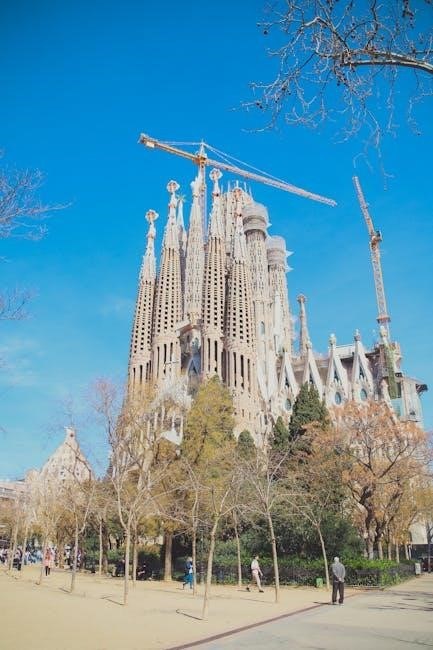Biography of Sandra Cisneros
Sandra Cisneros is a celebrated Chicana writer, born in Chicago to Mexican parents, whose work explores identity, culture, and coming-of-age themes. She gained recognition for her unique narrative style and blending of languages, reflecting her dual heritage. Cisneros has taught creative writing and continues to advocate for underrepresented voices in literature.
1.1 Early Life and Education
Sandra Cisneros was born in Chicago, Illinois, to Mexican parents, experiencing a childhood marked by frequent moves between the U.S. and Mexico. Her dual heritage influenced her writing, blending English and Spanish. She attended Loyola University Chicago, earning a B.A. in English, and later studied creative writing at the University of Iowa. Her early life, shaped by cultural displacement and a strong connection to her roots, inspired her unique narrative voice. These experiences laid the foundation for her exploration of identity and cultural themes in her work. Her education played a pivotal role in shaping her literary style, which reflects her blended heritage and emotional depth. Cisneros’ early years and academic background are central to understanding her artistic vision and contributions to Chicana literature.
1.2 Literary Career and Major Works
Sandra Cisneros, a renowned Chicana writer, rose to prominence with her debut novel The House on Mango Street, published in 1984. This coming-of-age story, written in vignettes, explores themes of identity, culture, and belonging through the eyes of Esperanza, a young Latina girl. The novel’s unique narrative structure and poetic prose have made it a landmark in Chicana literature. Cisneros’ other notable works include Caramelo, a sweeping family saga, and Woman Hollering Creek and Other Stories, which delve into themes of gender, identity, and cultural heritage. Her writing often blends English and Spanish, reflecting her dual heritage. Cisneros’ work has been widely praised for its emotional depth and authentic portrayal of the Chicana experience, solidifying her place as a leading voice in contemporary literature.
1.3 Cultural Impact and Recognition
Sandra Cisneros’ work has had a profound cultural impact, particularly in the Chicana community, by giving voice to underrepresented stories. Her novel The House on Mango Street has sold over six million copies worldwide, becoming a cornerstone of Chicana literature. Cisneros’ unique blending of English and Spanish reflects her dual heritage, resonating deeply with readers of diverse backgrounds. Her writing addresses themes of identity, gender, and cultural heritage, earning her widespread acclaim. Cisneros has been recognized with numerous awards and honors for her contributions to literature. Additionally, her work is being adapted into an opera, further cementing her legacy. Her ability to connect with readers through authentic and evocative storytelling has solidified her place as a leading figure in contemporary literature, inspiring future generations of writers and readers alike.

Overview of “La Casa en Mango Street”
La Casa en Mango Street, published in 1984, is a poignant coming-of-age novel by Sandra Cisneros, exploring themes of identity, culture, and adolescence through vivid vignettes.

2.1 Publication Details and Historical Context
La Casa en Mango Street, written by Sandra Cisneros, was first published in 1984 by Arte Público Press. The novel is composed of a series of interconnected vignettes, offering a unique narrative structure. Set in a Chicago neighborhood, the book captures the experiences of a young Latina girl navigating identity, culture, and adolescence. The Spanish translation of the book, La casa en Mango Street, has also been widely circulated, making Cisneros’ work accessible to Spanish-speaking readers. The novel’s release coincided with a growing interest in Chicana literature, positioning it as a landmark work in the genre. Its exploration of themes such as identity and cultural heritage resonated deeply, contributing to its enduring popularity and critical acclaim.
2.2 Plot Summary and Main Themes
La Casa en Mango Street follows Esperanza, a young Latina girl, as she navigates her life in a new Chicago neighborhood. The story, told through vivid vignettes, explores Esperanza’s struggles with identity, cultural heritage, and coming-of-age challenges. Themes of belonging, gender roles, and the tension between tradition and modernity are central to the narrative. Esperanza’s journey is marked by her desire to escape the limitations imposed by her surroundings and to find her own voice. The novel delves into universal adolescent experiences, such as friendship, family, and self-discovery, while also highlighting the unique perspectives of a Chicana protagonist. Through Esperanza’s story, Cisneros masterfully weaves together personal and cultural narratives, creating a poignant and relatable tale of growth and resilience.
2.4 The Protagonist Esperanza and Her Journey
Esperanza, the protagonist of La Casa en Mango Street, is a young Latina grappling with her identity and place in the world. Her journey is a poignant exploration of self-discovery, as she navigates the complexities of adolescence, cultural heritage, and societal expectations. Esperanza’s name, which means “hope” in Spanish, symbolizes her desire for a better future. Throughout the novel, she faces challenges such as gender roles, family dynamics, and the constraints of her neighborhood; Her experiences are deeply personal yet universally relatable, making her one of the most iconic characters in contemporary literature. Esperanza’s story is a powerful testament to the resilience of the human spirit and the enduring quest for self-definition.

Major Themes in Sandra Cisneros’ Work

Cultural identity, self-discovery, and gender roles are central themes in Cisneros’ work. Her exploration of adolescence and heritage resonates deeply, blending personal and universal experiences.
3;1 Identity and Self-Discovery
Sandra Cisneros’ work profoundly explores themes of identity and self-discovery, particularly through her Chicana protagonist Esperanza in La Casa en Mango Street. Esperanza’s journey reflects the struggle to reconcile her Mexican heritage with her American upbringing, navigating cultural expectations and personal aspirations. Cisneros highlights the duality of identity, as Esperanza grapples with her name’s meaning in Spanish, symbolizing a softer, more delicate essence, contrasting with her English identity. The novel captures the universal adolescent quest for belonging and self-acceptance, resonate across cultures and generations. Through vivid vignettes, Cisneros delves into the complexities of growing up Latina, addressing gender roles, language, and societal pressures. Her ability to blend personal narratives with broader cultural themes has made her a pivotal voice in contemporary literature.
3.2 Cultural Heritage and Language
Sandra Cisneros’ work is deeply rooted in her Chicana heritage, blending Mexican and American cultures. Her use of bilingual narratives reflects the duality of her identity, often incorporating Spanish phrases and cultural references. In La Casa en Mango Street, Esperanza’s experiences highlight the tension between preserving traditional heritage and adapting to a new cultural environment. Cisneros’ prose often juxtaposes English and Spanish, creating a linguistic landscape that mirrors her characters’ inner worlds; This blending of languages not only enriches the storytelling but also serves as a tool for cultural preservation and exploration. Her writing resonates with readers who navigate similar intersections of identity, making her a vital voice in exploring the complexities of cultural heritage through language.
3.3 Gender Roles and Social Expectations
Sandra Cisneros’ work critically examines gender roles and societal expectations, particularly within Latino culture. In La Casa en Mango Street, Esperanza confronts traditional notions of femininity and domesticity, resisting the limitations imposed on her by cultural norms. The novel portrays the tension between societal expectations of women and the desire for independence and self-discovery. Cisneros highlights the struggles of navigating these roles, especially for young Latina girls caught between cultural heritage and personal aspirations. Her writing challenges patriarchal norms, offering a powerful critique of gendered expectations and their impact on identity. Through Esperanza’s journey, Cisneros underscores the importance of questioning and redefining these roles, resonating deeply with readers grappling with similar societal pressures.
3;4 Coming-of-Age and Adolescence
Sandra Cisneros’ work, particularly La Casa en Mango Street, delves deeply into the themes of coming-of-age and adolescence. Esperanza’s journey mirrors the universal struggles of growing up, navigating identity, and understanding one’s place in the world. The novel captures the vulnerability and resilience of adolescence, exploring themes of body image, first crushes, and the search for belonging. Cisneros’ vivid portrayal of Esperanza’s experiences resonates with readers, offering a relatable and poignant depiction of the challenges and triumphs of youth. The book’s focus on the transition from childhood to adulthood highlights the emotional and psychological shifts that define this critical life stage, making it a timeless exploration of adolescent growth and self-discovery.

Literary Style and Technique
Sandra Cisneros employs a unique blend of vignettes, vivid imagery, and poetic language, creating a non-linear narrative style that captivates readers with emotional depth and cultural richness.
4.1 Narrative Structure and Vignettes
Sandra Cisneros’ work, particularly in La Casa en Mango Street, features a unique narrative structure composed of short, vivid vignettes. These fragmented scenes capture moments in Esperanza’s life, blending memory and emotion. The non-linear approach reflects her inner world, exploring themes like identity and culture. Each vignette focuses on a specific experience or character, creating a mosaic of her adolescence. This structure allows readers to piece together her journey, emphasizing the fragmented nature of growing up. Cisneros’ use of vignettes mirrors the disjointedness of memory, making the narrative feel both intimate and universal. This innovative style has been praised for its emotional depth and its ability to resonate with readers across cultures and languages, solidifying her reputation as a groundbreaking Latina writer.
4.2 Use of Language and Imagery
Sandra Cisneros’ writing is distinguished by her evocative use of language and imagery, which vividly captures the emotional and cultural landscapes of her characters. In La Casa en Mango Street, she employs a poetic and concise style, blending English and Spanish to reflect the duality of her Chicana identity. Her imagery often evokes sensory details—sights, sounds, and textures—that immerse readers in Esperanza’s world. Cisneros’ language is both lyrical and accessible, making her narratives feel deeply personal and relatable. The Spanish edition of her work retains this richness, underscoring her ability to connect with readers across linguistic and cultural boundaries. Her use of imagery not only enhances storytelling but also explores themes of identity, belonging, and memory, leaving a lasting emotional resonance with her audience.
4.3 Blending of English and Spanish
Sandra Cisneros seamlessly blends English and Spanish in her writing, reflecting her Chicana heritage and creating a unique linguistic identity. This bilingual approach enriches her narratives, allowing her to capture the nuances of cultural duality. In La Casa en Mango Street, Spanish phrases and expressions are woven naturally into the text, preserving the cultural essence of her characters’ lives. Cisneros often avoids translating Spanish words, as their meanings cannot be fully conveyed in English, emphasizing the importance of linguistic and cultural authenticity. This blending not only enhances the storytelling but also bridges gaps between languages, making her work accessible and relatable to both English and Spanish-speaking readers. The Spanish edition of her book maintains this duality, ensuring her voice resonates across cultures and languages, celebrating her identity and heritage. Her innovative use of language has become a hallmark of her literary style, fostering a deeper connection with her audience.

Reception and Legacy
Sandra Cisneros’ work has received widespread acclaim, with La Casa en Mango Street selling over six million copies. The book has been praised for its vivid portrayal of the Latina experience, earning critical acclaim and a loyal readership. Its success has led to translations and adaptations, including an upcoming opera, cementing Cisneros’ legacy as a pivotal figure in Chicana literature.
5.1 Critical Acclaim and Reviews
Sandra Cisneros’ work, particularly La Casa en Mango Street, has been widely praised for its lyrical prose and poignant exploration of identity, culture, and coming-of-age themes. Critics have hailed it as a landmark of Chicana literature, celebrating its vivid storytelling and emotional depth. The novel’s unique narrative structure, composed of interconnected vignettes, has been particularly acclaimed for its ability to capture the fragmented yet cohesive experience of Esperanza’s journey. Reviewers have also highlighted Cisneros’ innovative use of language, blending English and Spanish seamlessly to reflect the duality of her characters’ cultural identities. The book’s ability to resonate with both academic and general audiences has solidified its place as a modern classic. Its enduring popularity underscores its relevance in contemporary discussions of identity and belonging.
5.2 Commercial Success and Sales

La Casa en Mango Street has achieved remarkable commercial success, selling over six million copies worldwide since its publication in 1984. Its enduring popularity has made it a modern classic, with widespread recognition in both English and Spanish markets. The Spanish PDF version has further expanded its reach, catering to Spanish-speaking readers globally. The book’s relatability and universal themes have contributed to its sustained sales, making it a staple in educational curriculums and personal libraries. Its success has also been bolstered by its availability in digital formats, ensuring accessibility for contemporary readers. The novel’s impact extends beyond sales, as it remains a cornerstone of Chicana literature, continuing to inspire new generations of readers and writers. Its commercial success underscores its cultural significance and timeless appeal.
5.3 Adaptations and Future Projects
Sandra Cisneros is collaborating with composer Derek Bermel on an opera adaptation of The House on Mango Street, marking a new creative milestone. This project aims to bring Esperanza’s story to the stage, blending music and literature. Additionally, Cisneros has expressed interest in exploring her Chicana heritage through future works, potentially delving into bilingual storytelling. Her recent book, Martita, te recuerdo, highlights her continued dedication to narratives about identity and memory. Fans can expect more innovative projects that bridge language and culture, further cementing her legacy as a groundbreaking author. Her work continues to inspire adaptations and collaborations, ensuring her stories reach diverse audiences in fresh and exciting ways.

Resources and Availability
La Casa en Mango Street is widely available in Spanish PDF formats online, including major retailers and libraries. The Spanish edition can be found on platforms like Amazon and Google Books, while related books by Sandra Cisneros are also recommended for further reading.
6.1 PDF Versions and Digital Formats
La Casa en Mango Street by Sandra Cisneros is widely available in Spanish PDF and digital formats, ensuring accessibility for global readers. The book can be downloaded from platforms like Amazon, Google Books, and Apple Books, offering convenience for e-reader users. Additionally, many libraries provide digital copies through apps like Libby, allowing borrowers to access the book for free. The PDF version is popular among students and researchers for its ease of use and portability. With millions of copies sold worldwide, its digital formats have further expanded its reach, making it a staple in contemporary Latinx literature. Readers can also find it on educational platforms, highlighting its academic relevance and enduring popularity.
6.2 Where to Find the Spanish Edition
The Spanish edition of Sandra Cisneros’ La Casa en Mango Street is widely available in various formats. Readers can find it in major bookstores like Amazon, Barnes & Noble, and independent bookshops. Additionally, libraries often carry copies, both in physical and digital formats. For digital readers, platforms such as Apple Books and Google Play Books offer the Spanish version for download. PDF versions are also accessible through online retailers and educational websites, making it easy for students and enthusiasts to access the text. The book’s popularity has led to its availability in numerous countries, ensuring that Spanish-speaking audiences worldwide can enjoy this iconic work of Chicana literature.
6;3 Related Books and Recommendations

Readers interested in Sandra Cisneros’ work may enjoy her other notable books, such as Caramelo and Mujer sin vergüenza. These works explore similar themes of identity, culture, and personal growth. Additionally, fans of her lyrical prose might appreciate The House on Mango Street in its Spanish translation, La Casa en Mango Street, which maintains the poetic essence of the original. For those seeking similar authors, Junot Díaz’s The Brief Wondrous Life of Oscar Wao offers a rich blend of cultural identity and storytelling. These recommendations provide a deeper dive into Chicana literature and the experiences of Latinx communities, ensuring a fulfilling reading journey beyond Cisneros’ iconic novel.
